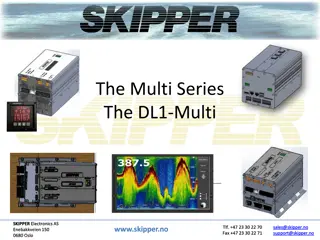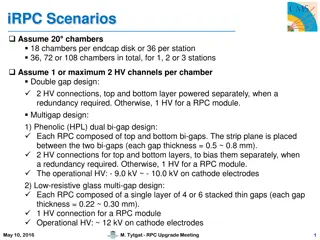Anomalous IP Processing Electronics Diagnostic Tests
Repeating some anomalous IP processing electronics diagnostic tests on the first stage and the limiter. Tests include checking for unwanted harmonics in the frequency multiplier output and observing changes in the output power with varying input power. Issues with the output of the limiter diode and beam intensity monitor are also discussed.
Download Presentation

Please find below an Image/Link to download the presentation.
The content on the website is provided AS IS for your information and personal use only. It may not be sold, licensed, or shared on other websites without obtaining consent from the author.If you encounter any issues during the download, it is possible that the publisher has removed the file from their server.
You are allowed to download the files provided on this website for personal or commercial use, subject to the condition that they are used lawfully. All files are the property of their respective owners.
The content on the website is provided AS IS for your information and personal use only. It may not be sold, licensed, or shared on other websites without obtaining consent from the author.
E N D
Presentation Transcript
IP electronics tests N. Blaskovic, T. Bromwich, R. Ramjiawan Wednesday, 1 March 2017 FONT 1
Outline Repeating some of the anomalous IP processing electronics diagnostic tests on the first stage and the limiter. Check for unwanted harmonics in the output of the frequency multiplier Look at the output of the first stage electronics with changing input power. - The output power was previously found to not be decreasing with input power at low levels. Look at the outputs of the limiting amplifier with changing input power. - Output of the limiter diode in previously tests showed discontinuities due to difficulties using the oscilloscope. - Output voltage of the beam intensity monitor was previously observed to be very jittery. Wednesday, 1 March 2017 FONT 2
Reminder of IP electronics First test: output of the frequency multiplier Second test: output of the first stage reference Third test: outputs of the limiter; both the limited reference going into the second stage (Ref LO RF), and the reference diode (beam intensity monitor) Wednesday, 1 March 2017 FONT 3
Output of the frequency multiplier y = 6.4 GHz x = 5.7 GHz Damping Ring 714 MHz SPECTRUM ANALYSER Frequency Multiplier Working without beam, look at the output of the frequency multiplier on a spectrum analyser. Wednesday, 1 March 2017 FONT 4
Outputs of the frequency multiplier Look at the output of the 1st stage frequency multiplier using a spectrum analyser. Check the levels of 714MHz and other unwanted harmonics (particularly, +/-714MHz from the wanted output) Both Y (5.712GHz) and X (6.426 GHz) LO outputs show peaks +/- 10 MHz either side of the required frequency. Wednesday, 1 March 2017 FONT 5
Outputs of the frequency multiplier 1GHz span scans from 0 to 10 GHz on both Y and X outputs to look for unwanted harmonics. Only non-wanted peak found on X (6.426 GHz) LO output at Y LO frequency of 5.712 GHz, very low levels. Wednesday, 1 March 2017 FONT 6
Reference output of first-stage FIRST STAGE MIXER SIGNAL GENERATOR Dipole y = 6.4 GHz x = 5.7 GHz 714 MHz SPECTRUM ANALYSER Reference Damping Ring 714 MHz Frequency Multiplier Working without beam, use a signal generator to produce 6.426 GHz. Look at the outputs of the first stage on a spectrum analyser. Change the strength of the signal generator to vary input power. Monitor reference output power as a function of input power. Wednesday, 1 March 2017 FONT 7
Reference output of first-stage This is the plot that in previous tests showed the output powers not decreasing as the input powers were decreased to very low levels. This was found to be a fault with the signal generator which becomes unlevelled below 20 dBm. This new data was taken by placing 40 dB attenuation on the input signal to reach lower attenuation ranges. Linear operating range below -25 dBm. We typically place 50 dB attenuation on the reference input to the first stage. Wednesday, 1 March 2017 FONT 8
Reference output of first-stage Lots of frequency multiples observed in the first stage output. These are (mostly) removed by the limiter, but they are recorded here anyway, along with their output power levels as measured on the spectrum analyser given an input signal ~ -20 dBm. Frequency (GHz) Output Power (dBm) 0.714 1.433 2.141 3.921 4.287 5.717 6.426 7.140 -2.3 -55.8 -31.2 -55.8 -46.6 -12.3 -26.1 -41.2 Example screenshots of spectrum analyser. Above: 714 MHz peak at -2.4 dBm. Below 5.7 GHz peak at -12.3 dBm. Wednesday, 1 March 2017 FONT 9
Output of the limiting amplifier FIRST STAGE MIXER SIGNAL GENERATOR Dipole y = 6.4 GHz x = 5.7 GHz SPECTRUM ANALYSER or SCOPE 714 MHz Limiting Amplifier Reference Damping Ring 714 MHz Frequency Multiplier Provide the input to the first stage using a signal generator. Change the strength of the signal generator to vary input power. Monitor one of the output channels and the limiter diode. Wednesday, 1 March 2017 FONT 10
Output of the limiting amplifier Output of the Y limiting amplifier, channel RefLO #1, at 714 MHz, as a function of the 6.426 GHz input power to the first stage electronics Wednesday, 1 March 2017 FONT 11
Output of the limiting amplifier Almost all frequency multiples observed in the first stage output have been removed by the limiter. There is a very low-level peak observed at 1.43 GHz (see screenshots right). Frequency (GHz) Output Power (dBm) 0.714 1.428 0.4 -46.9 The two peaks +/- 10 MHz either side of the 714 MHz (first observed when we tested the set-up briefly in the first week) are still clearly visible. Wednesday, 1 March 2017 FONT 12
Output of the limiting amplifier - beam intensity monitor Output of the Y limiting amplifier, beam intensity monitor, measured as a DC voltage level on the oscilloscope at different input powers to the first stage electronics. Wednesday, 1 March 2017 FONT 13
Output of the limiting amplifier - beam intensity monitor On previous tests we saw a very jittery signal at discreet values. We hoped this was just a user error with the 1GHz scope settings. Week 1, shown left, we were able to observe a static DC signal on the 200 MHz scope. Week 2, shown right, using the 200 MHz scope again, shows a varying signal. What are we doing wrong with the settings? Scope settings Wk 1 200ns per division 2 V per division Scope settings Wk 2 10 ms per division 100 mV per division Wednesday, 1 March 2017 FONT 14
Conclusion Checked for unwanted harmonics in the output of the frequency multiplier - Found two peaks +/- 10 MHz of the 714 MHz. Looked at the output of the first stage electronics with changing input power. - The output power is now decreasing with input power at low levels. - Many multiples of 714 MHz observed in the output using the spectrum analyzer. Looked at the outputs of the limiting amplifier with changing input power. - Output power plotted as function of input power to the first stage. - Slight remnant of 2 x 714 MHz signal observed on spectrum analyzer. - Two side peaks +/- 10 MHz of the 714 MHz still observed. - Output voltage of the beam intensity monitor plotted as a function of input power to the first stage. - Some oscillation still observed in the output signal. User error? Wednesday, 1 March 2017 FONT 15























